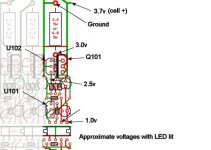Patriot
10 kW
- Joined
- Aug 7, 2008
- Messages
- 511
OK, I checked the large resistor legs on the far end where they connect to the board, right next to the channel lead connections. Here's the voltages I got between them.
1-2 - 3.35v
2-3 - 0.00v
3-4 - 1.82v
5-6 - 3.35v
6-7 - 0.00v
7-8 - 1.83v
So, the voltages appeared to have the same pattern between the two banks.
I also checked the channel leads at the point of contact on the board. They all read 3.35v.
Just got home from the night shift. I'm off to bed. I'll be back this afternoon.
1-2 - 3.35v
2-3 - 0.00v
3-4 - 1.82v
5-6 - 3.35v
6-7 - 0.00v
7-8 - 1.83v
So, the voltages appeared to have the same pattern between the two banks.
I also checked the channel leads at the point of contact on the board. They all read 3.35v.
Just got home from the night shift. I'm off to bed. I'll be back this afternoon.



